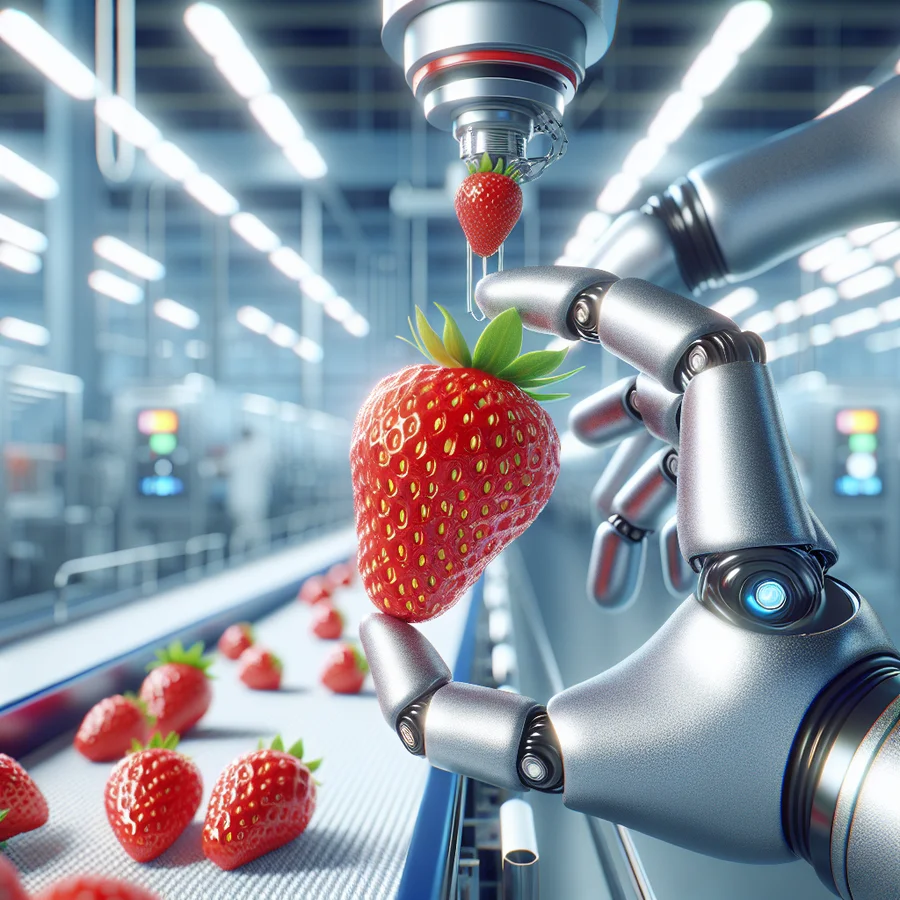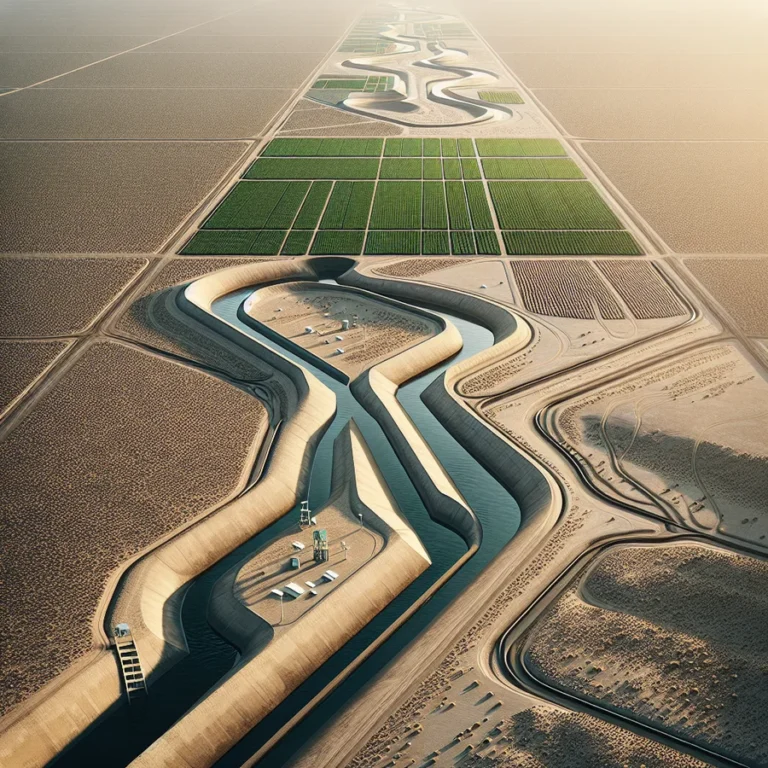AI in Food Technology: Enhancing Production and Reducing Waste
Imagine a world where food production is more efficient, waste is minimized, and the food we eat is safer and more nutritious. This isn’t a futuristic fantasy; it’s the reality that AI in food technology is rapidly creating. From farm to table, artificial intelligence is revolutionizing how we grow, process, and distribute food.
This guide explores the exciting ways AI in food technology is transforming the food industry. We’ll dive into how it enhances production, reduces waste, improves quality control, and even personalizes nutrition. Get ready to discover how AI is shaping the future of food!
Understanding the Role of AI in Food Technology
Artificial intelligence (AI) is no longer just a buzzword. It’s a powerful tool that’s making waves across various industries. In the food sector, AI refers to the use of computer systems to perform tasks that typically require human intelligence. This includes learning, problem-solving, and decision-making.
Reminder: AI isn’t about replacing humans. It’s about augmenting our capabilities and making processes more efficient.
AI achieves this through various techniques, including:
- Machine Learning (ML): Algorithms learn from data without explicit programming. They identify patterns and make predictions.
- Computer Vision: AI systems “see” and interpret images, enabling automated inspection and quality control.
- Predictive Analytics: Using data to forecast future trends and outcomes, helping with demand planning and waste reduction.
- Robotics: AI-powered robots automate tasks like sorting, packaging, and harvesting.
These technologies are transforming the food industry, offering solutions to challenges related to production, safety, and sustainability.
Enhancing Food Production with AI
One of the most significant impacts of AI in food technology is its ability to enhance production efficiency. Traditional farming and food processing methods often involve guesswork and inefficiencies. AI provides data-driven insights that optimize every stage of the process.
Precision Farming: Optimizing Crop Yields with AI
Precision farming utilizes AI to optimize crop yields by analyzing data from various sources. This includes weather patterns, soil conditions, and plant health. By understanding these factors, farmers can make informed decisions about irrigation, fertilization, and pest control.
Here’s how AI contributes to precision farming:
- Weather Forecasting: AI algorithms analyze weather data to predict rainfall, temperature fluctuations, and other environmental factors. This allows farmers to prepare for potential challenges and adjust their planting schedules accordingly.
- Soil Monitoring: Sensors and drones collect data on soil nutrient levels, moisture content, and pH levels. AI analyzes this data to create detailed soil maps, allowing farmers to apply fertilizers and water more efficiently.
- Pest and Disease Detection: AI-powered systems can identify early signs of pest infestations and plant diseases using images captured by drones or sensors. This enables farmers to take targeted action, minimizing the use of pesticides and preventing widespread crop damage.
Example: Imagine a farmer using AI-powered drones to monitor their crops. The drones capture images of the plants, and AI algorithms analyze these images to detect signs of nutrient deficiencies. The farmer can then apply fertilizer only to the areas that need it, reducing waste and improving overall crop health.
Optimizing Food Processing with AI
AI isn’t just beneficial on the farm; it also plays a crucial role in optimizing food processing. From sorting and grading to packaging and quality control, AI-powered systems are improving efficiency and reducing errors.
Here are some specific applications:
- Automated Sorting and Grading: Computer vision systems can inspect food items in real-time, identifying defects and sorting products based on size, shape, and color. This ensures that only high-quality products make it to the next stage of processing.
- Predictive Maintenance: AI algorithms analyze data from equipment sensors to predict potential failures. This allows manufacturers to schedule maintenance proactively, minimizing downtime and preventing costly repairs.
- Optimized Production Schedules: AI can analyze historical data and market trends to optimize production schedules, ensuring that the right amount of product is produced at the right time. This reduces waste and improves efficiency.
Note: By automating tasks and providing data-driven insights, AI helps food processors streamline their operations and reduce costs.
Reducing Food Waste with AI
Food waste is a massive global problem, with significant economic and environmental consequences. According to the Food and Agriculture Organization, nearly one-third of all food produced globally is lost or wasted each year. AI in food technology offers powerful solutions to combat this issue.
Demand Forecasting: Predicting Consumer Needs with AI
One of the primary drivers of food waste is inaccurate demand forecasting. Retailers and restaurants often overstock items, leading to spoilage and waste. AI can improve demand forecasting by analyzing historical sales data, weather patterns, and other relevant factors.
Here’s how AI-powered demand forecasting works:
- Data Collection: AI systems collect data from various sources, including point-of-sale systems, inventory management systems, and external data sources like weather forecasts and social media trends.
- Pattern Recognition: Machine learning algorithms analyze this data to identify patterns and correlations. For example, they might discover that sales of ice cream increase on hot days or that certain products are more popular during specific holidays.
- Predictive Modeling: Based on these patterns, AI creates predictive models that forecast future demand. These models can take into account seasonal variations, promotional events, and other factors that might influence sales.
Reminder: Accurate demand forecasting allows retailers and restaurants to order the right amount of product, minimizing overstocking and reducing waste.
Optimizing Inventory Management using AI
Even with accurate demand forecasts, efficient inventory management is crucial for minimizing food waste. AI can help optimize inventory levels by tracking product expiration dates, monitoring storage conditions, and identifying slow-moving items.
Here are some ways AI improves inventory management:
- Real-Time Tracking: AI-powered systems track inventory levels in real-time, providing visibility into product availability and expiration dates.
- Automated Alerts: When products are nearing their expiration dates, AI systems can send automated alerts to staff, prompting them to take action, such as marking down prices or donating the items to food banks.
- Dynamic Pricing: AI can adjust prices dynamically based on demand and expiration dates. This helps move slow-moving items and reduces the likelihood of spoilage.
Example: A grocery store uses AI to track the expiration dates of its produce. When a batch of strawberries is nearing its expiration date, the AI system automatically reduces the price and sends a notification to customers through the store’s mobile app. This encourages customers to purchase the strawberries, preventing them from going to waste.
Smart Packaging: Monitoring Food Freshness with AI
Another innovative application of AI in food technology is smart packaging. Smart packaging incorporates sensors and indicators that monitor food freshness and alert consumers when a product is no longer safe to eat.
Here are some examples of smart packaging technologies:
- Time-Temperature Indicators: These indicators change color or display a message to indicate whether a product has been exposed to unsafe temperatures.
- Gas Sensors: These sensors detect the presence of gases that indicate spoilage, such as ammonia or volatile organic compounds.
- RFID Tags: These tags allow for real-time tracking of product location and temperature throughout the supply chain.
Note: Smart packaging empowers consumers to make informed decisions about food safety and reduces the risk of consuming spoiled products.
Improving Food Safety and Quality with AI
Food safety is paramount in the food industry. Consumers need to trust that the food they eat is safe and free from contaminants. AI in food technology offers powerful tools for improving food safety and quality control.
Automated Inspection: Detecting Contaminants with AI
Traditional methods of food inspection often rely on manual labor and can be prone to human error. AI-powered computer vision systems can automate the inspection process, detecting contaminants and defects with greater accuracy and speed.
Here’s how automated inspection works:
- Image Acquisition: Cameras capture images of food products as they move along a production line.
- Image Analysis: AI algorithms analyze these images to identify potential contaminants, such as foreign objects, mold, or discoloration.
- Automated Rejection: If a contaminant is detected, the AI system can automatically reject the product, preventing it from reaching consumers.
Example: A food processing plant uses AI-powered cameras to inspect packages of spinach for foreign objects. The AI system can detect even small pieces of plastic or insects, ensuring that only safe and high-quality spinach is packaged and sold.
Predictive Analytics: Preventing Foodborne Illnesses with AI
AI can also be used to predict and prevent foodborne illnesses. By analyzing data from various sources, such as public health records, social media, and news reports, AI algorithms can identify potential outbreaks and alert authorities.
Here’s how AI helps prevent foodborne illnesses:
- Data Aggregation: AI systems collect data from various sources, including health departments, social media platforms, and news outlets.
- Pattern Identification: Machine learning algorithms analyze this data to identify patterns and correlations that might indicate a potential outbreak.
- Risk Assessment: Based on these patterns, AI can assess the risk of a foodborne illness outbreak and alert authorities.
Reminder: Early detection of potential outbreaks allows for swift action, minimizing the spread of illness and protecting public health.
Personalizing Nutrition with AI
AI in food technology isn’t just about efficiency and safety; it’s also about personalizing nutrition. AI can analyze individual dietary needs and preferences to provide customized food recommendations and meal plans.
Analyzing Dietary Needs with AI
AI-powered apps and platforms can collect data on individual dietary needs, including allergies, intolerances, and health conditions. This data is then used to generate personalized food recommendations and meal plans.
Here’s how AI analyzes dietary needs:
- Data Collection: Users input information about their dietary restrictions, health conditions, and preferences into an AI-powered app or platform.
- Nutritional Analysis: AI algorithms analyze this data to determine the user’s specific nutritional needs.
- Recommendation Generation: Based on this analysis, AI generates personalized food recommendations and meal plans that meet the user’s needs and preferences.
Example: A person with celiac disease uses an AI-powered app to find gluten-free recipes. The app analyzes the user’s dietary restrictions and suggests recipes that are safe and delicious.
Creating Personalized Meal Plans with AI
AI can also create personalized meal plans that take into account individual dietary needs, preferences, and goals. These meal plans can help people eat healthier, lose weight, or manage chronic conditions.
Here’s how AI creates personalized meal plans:
- Goal Setting: Users set goals, such as losing weight or managing diabetes.
- Preference Input: Users specify their food preferences, including favorite foods and cuisines.
- Meal Plan Generation: AI algorithms generate a personalized meal plan that meets the user’s goals and preferences.
Note: Personalized meal plans make it easier for people to stick to their dietary goals and improve their overall health.
Case Studies: Real-World Applications of AI in Food Technology
The benefits of AI in food technology are not just theoretical. Many companies are already using AI to improve their operations and deliver better products to consumers.
Church Brothers Farms: Optimizing Supply Chains with AI
Church Brothers Farms, a large vegetable grower, faced challenges related to product perishability and volatile market conditions. They partnered with Throughput.ai to optimize their supply chain using AI.
Throughput.ai’s tool analyzed historical data to provide accurate demand forecasting and optimize workflows. This resulted in a 40% increase in short-term forecasting accuracy and more efficient inventory management.
A Fast-Growing Coffee Retail Chain: Reducing Waste and Improving Efficiency with AI
A coffee retail chain used Throughput.ai’s Supply Chain Intelligence software to optimize its product offerings and improve inventory management. The AI-powered tool provided insights into inventory turnover and customer reorder frequencies, allowing the chain to reduce inventory levels by 15% and increase labor productivity by 5%.
Beyond Meat: Enhancing Plant-Based Alternatives with AI
Beyond Meat uses AI and machine learning to improve the flavor and texture of its plant-based meat alternatives. The company analyzes sensory data and user feedback to optimize its recipes and create products that closely mimic the taste and texture of animal meat.
Challenges and Considerations of AI in the Food Industry
While AI in food technology offers numerous benefits, there are also challenges and considerations to keep in mind.
Data Privacy and Security Concerns
AI systems rely on vast amounts of data, including consumer data and operational data. This raises concerns about data privacy and security. Food companies must implement robust security measures to protect sensitive data from breaches and unauthorized access.
Technical and Financial Barriers to AI Adoption
Implementing AI technologies can be expensive, especially for small and medium-sized businesses. There may also be technical barriers, such as a lack of skilled personnel to manage AI systems. However, the long-term benefits of AI adoption often outweigh the initial costs.
Need for Skilled Personnel to Manage AI Technologies
Successfully implementing and managing AI technologies requires skilled personnel with expertise in data science, machine learning, and food science. Food companies need to invest in training and development to ensure that their employees have the skills necessary to work with AI systems.
Future Trends and Predictions of AI in the Food Industry
The future of AI in food technology is bright. As AI technologies continue to evolve, we can expect to see even more innovative applications in the food industry.
Here are some future trends and predictions:
- Increased Automation: AI-powered robots will become more prevalent in food processing plants, automating tasks such as sorting, packaging, and cleaning.
- Advanced Sensors: New and improved sensors will provide more detailed data on food quality and safety, enabling more precise monitoring and control.
- Personalized Nutrition at Scale: AI will enable the creation of personalized nutrition plans and food products at scale, catering to individual dietary needs and preferences.
- Sustainable Food Systems: AI will play a key role in creating more sustainable food systems by optimizing resource use, reducing waste, and promoting environmentally friendly practices.
Reminder: Embracing AI is essential for food companies that want to stay competitive and meet the evolving needs of consumers.
The Role of AI in Sustainable Food Production
AI can significantly contribute to sustainable food production by optimizing resource utilization and minimizing environmental impact. For instance, AI-driven systems can precisely monitor and manage water usage in irrigation, reducing water waste and promoting water conservation. Similarly, AI can optimize fertilizer application, ensuring that crops receive the right amount of nutrients without excessive use of chemicals that can harm the environment.
AI-Driven Logistics for Reduced Emissions
AI-driven logistics solutions can optimize delivery routes, taking into account real-time traffic conditions, weather forecasts, and delivery windows. This leads to more efficient fuel usage and reduced delivery times, minimizing the carbon footprint of food transportation. Furthermore, AI can help predict and prevent disruptions in the supply chain, ensuring that food products reach their destination in a timely manner, reducing the risk of spoilage and waste.
AI and Blockchain for Enhanced Traceability
Combining AI with blockchain technology can enhance product traceability from farm to table, ensuring compliance with food safety protocols. Blockchain provides a secure and transparent record of the entire supply chain, while AI can analyze this data to identify potential risks and optimize processes. This combination of technologies can help build consumer trust and ensure the integrity of the food supply.
AI in Developing Novel Food Products
AI is also playing a key role in the development of novel food products that are both nutritious and sustainable. For example, AI can analyze the molecular composition of plants to identify potential health benefits, paving the way for the creation of new and beneficial ingredients. Additionally, AI can help optimize the formulation of plant-based alternatives, ensuring that they closely mimic the taste, texture, and nutritional profile of animal products.
Conclusion
AI in food technology is revolutionizing the way we produce, process, and consume food. From enhancing production efficiency and reducing waste to improving food safety and personalizing nutrition, AI offers a wide range of benefits. While there are challenges to overcome, the potential of AI to transform the food industry is undeniable.
By embracing AI, food companies can create more sustainable, efficient, and consumer-centric food systems. The future of food is intelligent, and AI is leading the way.
FAQs About AI in Food Technology
How does AI help in reducing food waste?
AI helps reduce food waste through accurate demand forecasting, optimized inventory management, and smart packaging. AI algorithms analyze historical data to predict consumer demand, allowing retailers and restaurants to order the right amount of product. AI-powered systems track inventory levels in real-time, alerting staff when products are nearing their expiration dates. Smart packaging incorporates sensors that monitor food freshness and alert consumers when a product is no longer safe to eat.
What are some examples of AI applications in food safety?
AI improves food safety through automated inspection, predictive analytics, and enhanced traceability. Computer vision systems can inspect food products in real-time, detecting contaminants and defects with greater accuracy and speed. AI algorithms analyze data from various sources to predict and prevent foodborne illnesses. Combining AI with blockchain technology enhances product traceability from farm to table.
How can AI personalize nutrition for individuals?
AI can personalize nutrition by analyzing individual dietary needs and preferences to provide customized food recommendations and meal plans. AI-powered apps and platforms collect data on dietary restrictions, health conditions, and preferences. This data is then used to generate personalized food recommendations and meal plans that meet the user’s specific needs and goals.
What are the main challenges in implementing AI in the food industry?
The main challenges include data privacy and security concerns, technical and financial barriers to AI adoption, and the need for skilled personnel to manage AI technologies. Food companies must implement robust security measures to protect sensitive data. Implementing AI technologies can be expensive, especially for small businesses. Successfully implementing and managing AI technologies requires skilled personnel with expertise in data science, machine learning, and food science.
What are some future trends to expect in AI for food technology?
Future trends include increased automation in food processing plants, advanced sensors for more detailed data on food quality, personalized nutrition at scale, and the development of more sustainable food systems. AI-powered robots will automate tasks such as sorting, packaging, and cleaning. New and improved sensors will provide more precise monitoring and control of food quality and safety. AI will enable the creation of personalized nutrition plans and food products at scale. AI will play a key role in optimizing resource use, reducing waste, and promoting environmentally friendly practices.






